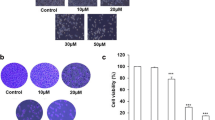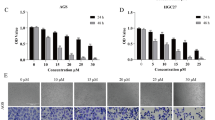Abstract
Various antidepressants, mainly tricyclic antidepressants (TCAs) and selective serotonin reuptake inhibitors (SSRIs), have exhibited potent anticancer properties in different cancer cell types. In the present study, desipramine (DMI), a representative of TCAs, was examined with respect to its apoptosis-inducing activity in rat C6 glioma cells and the underlying mechanism of action. DMI induced typical apoptotic morphology of chromatin condensation in rat glioma C6 cells and activated intracellular caspase 9 and caspase 3 with no change in mitochondrial membrane potential. Simultaneously, DMI significantly elevated expression of endoplasmic reticulum stress regulator CHOP/GADD153 and its targeting molecule GADD34. However, knockdown of CHOP by CHOP-specific short interfering RNA (siRNA) could decrease the activity of intracellular caspase 3 and the cytotoxicity of DMI to C6 cells. These results revealed that the CHOP-dependent endoplasmic reticulum (ER) stress pathway is responsible for DMI-induced apoptosis in C6 cells.






Similar content being viewed by others
References
Verdu B, Decosterd I, Buclin T, Stiefel F, Berney A (2008) Antidepressants for the treatment of chronic pain. Drugs 68:2611–2632
Xu W, Tamim H, Shapiro S, Stang MR, Collet JP (2006) Use of antidepressants and risk of colorectal cancer: a nested case-control study. Lancet Oncol 7:301–308. doi:10.1016/S1470-2045(06)70622-2
Coogan PF, Strom BL, Rosenberg L (2009) Antidepressant use and colorectal cancer risk. Pharmacoepidemiol Drug Saf 18:1111–1114. doi:10.1002/pds.1808
Levkovitz Y, Gil-Ad I, Zeldich E, Dayag M, Weizman A (2005) Differential induction of apoptosis by antidepressants in glioma and neuroblastoma cell lines: evidence for p-c-Jun, cytochrome c, and caspase-3 involvement. J Mol Neurosci 27:29–42. doi:10.1385/JMN:27:1:029
Chou CT, He S, Jan CR (2007) Paroxetine-induced apoptosis in human osteosarcoma cells: activation of p38 MAP kinase and caspase-3 pathways without involvement of [Ca2+]i elevation. Toxicol Appl Pharmacol 218:265–273. doi:10.1016/j.taap.2006.11.012
Stepulak A, Rzeski W, Sifringer M, Brocke K, Gratopp A, Kupisz K, Turski L, Ikonomidou C (2008) Fluoxetine inhibits the extracellular signal regulated kinase pathway and suppresses growth of cancer cells. Cancer Biol Ther 7:1685–1693
Frick LR, Palumbo ML, Zappia MP, Brocco MA, Cremaschi GA, Genaro A (2008) Inhibitory effect of fluoxetine on lymphoma growth through the modulation of antitumor T-cell response by serotonin-dependent and independent mechanisms. Biochem Pharmacol 75:1817–1826. doi:10.1016/j.bcp.2008.01.015
Gil-Ad I, Zolokov A, Lomnitski L, Taler M, Bar M, Luria D, Ram E, Weizman A (2008) Evaluation of the potential anti-cancer activity of the antidepressant sertraline in human colon cancer cell lines and in colorectal cancer-xenografted mice. Int J Oncol 33:277–286
Peer D, Margalit R (2006) Fluoxetine and reversal of multidrug resistance. Cancer Lett 237:180–187. doi:10.1016/j.canlet.2005.06.003
Bilir A, Erguven M, Oktem G, Ozdemir A, Uslu A, Aktas E, Bonavida B (2008) Potentiation of cytotoxicity by combination of imatinib and chlorimipramine in glioma. Int J Oncol 32:829–839
Amit BH, Gil-Ad I, Taler M, Bar M, Zolokov A, Weizman A (2009) Proapoptotic and chemosensitizing effects of selective serotonin reuptake inhibitors on T cell lymphoma/leukemia (Jurkat) in vitro. Eur Neuropsychopharmacol 19:726–734. doi:10.1016/j.euroneuro.2009.06.003
Kinjo T, Kowalczyk P, Kowalczyk M, Walaszek Z, Nishimaki T, Slaga TJ, Hanausek M (2009) Desipramine inhibits the growth of a mouse skin squamous cell carcinoma cell line and affects glucocorticoid receptor-mediated transcription. Mol Carcinog 48:1123–1130. doi:10.1002/mc.20564
Arimochi H, Morita K (2006) Characterization of cytotoxic actions of tricyclic antidepressants on human HT29 colon carcinoma cells. Eur J Pharmacol 541:17–23. doi:10.1016/j.ejphar.2006.04.053
Arimochi H, Morita K (2008) Desipramine induces apoptotic cell death through nonmitochondrial and mitochondrial pathways in different types of human colon carcinoma cells. Pharmacology 81:164–172. doi:10.1159/000111144
Huang CJ, Cheng HH, Chou CT, Kuo CC, Lu YC, Tseng LL, Chu ST, Hsu SS, Wang JL, Lin KL, Chen IS, Liu SI, Jan CR (2007) Desipramine-induced Ca2+ movement and cytotoxicity in PC3 human prostate cancer cells. Toxicol In Vitro 21:449–456. doi:10.1016/j.tiv.2006.10.011
Lu T, Huang CC, Lu YC, Lin KL, Liu SI, Wang BW, Chang PM, Chen IS, Chen SS, Tsai JY, Chou CT, Jan CR (2009) Desipramine-induced Ca-independent apoptosis in Mg63 human osteosarcoma cells: dependence on P38 mitogen-activated protein kinase-regulated activation of caspase 3. Clin Exp Pharmacol Physiol 36:297–303. doi:10.1111/j.1440-1681.2008.05065.x
Qi H, Chen HZ, Jin ZJ (2002) Caspase 3 gene expression and [Ca2+]i homeostasis underlying desipramine-induced C6 glioma cell apoptosis. Acta Pharmacol Sin 23:803–807
Ghosh RN, Lapets O, Haskins JR (2007) Characteristics and value of directed algorithms in high content screening. Methods Mol Biol 356:63–8121
Lu Q, Yu DH, Fang C, Liu F, Ye X, Zhao Y, Qin J, Guo XK, Liang M, Hu F (2009) Influence of E3 region on conditionally replicative adenovirus mediated cytotoxicity in hepatocellular carcinoma cells. Cancer Biol Ther 8:1125–1132
Bertelsen M, Sanfridson A (2005) Inflammatory pathway analysis using a high content screening platform. Assay Drug Dev Technol 3:261–271. doi:10.1089/adt.2005.3.261
Chen G, Fan Z, Fan X, Ma C, Bower KA, Shi X, Ke ZJ, Luo J (2007) Brain-derived neurotrophic factor suppresses tunicamycin-induced upregulation of CHOP in neurons. J Neurosci Res 85:1674–1684. doi:10.1002/jnr.21292
Penninx BW, Guralnik JM, Pahor M, Ferrucci L, Cerhan JR, Wallace RB, Havlik RJ (1998) Chronically depressed mood and cancer risk in older persons. J Natl Cancer Inst 90:1888–1893
Pilkington GJ, Parker K, Murray SA (2008) Approaches to mitochondrially mediated cancer therapy. Semin Cancer Biol 18:226–235. doi:10.1016/j.semcancer.2007.12.006
Daley E, Wilkie D, Loesch A, Hargreaves IP, Kendall DA, Pilkington GJ, Pilkington TE (2005) Chlorimipramine: a novel anticancer agent with a mitochondrial target. Biochem Biophys Res Commun 328:623–632. doi:10.1016/j.bbrc.2005.01.028
Chang HC, Huang CC, Huang CJ, Cheng JS, Liu SI, Tsai JY, Chang HT, Huang JK, Chou CT, Chou CR (2008) Despramine-induced apoptosis in human PC3 prostate cancer cells: activation of JNK kinase and caspase-3 pathways and a protective role of [Ca2+]i elevation. Toxicology 250:9–14. doi:10.1016/j.tox.2008.05.010
Rasheva VI, Domingos PM (2009) Cellular responses to endoplasmic reticulum stress and apoptosis. Apoptosis 14:996–1007. doi:10.1007/s10495-009-0341-y
Schröder M (2008) Endoplasmic reticulum stress responses. Cell Mol Life Sci 65:862–894. doi:10.1007/s00018-007-7383-5
Sánchez AM, Martínez-Botas J, Malagarie-Cazenave S, Olea N, Vara D, Lasunción MA, Díaz-Laviada I (2008) Induction of the endoplasmic reticulum stress protein GADD153/CHOP by capsaicin in prostate PC-3 cells: a microarray study. Biochem Biophys Res Commun 372:785–791. doi:10.1016/j.bbrc.2008.05.138
Blaschke F, Bruemmer D, Yin F, Takata Y, Wang W, Fishbein MC, Okura T, Higaki J, Graf K, Fleck E, Hsueh WA, Law RE (2004) C-reactive protein induces apoptosis in human coronary vascular smooth muscle cells. Circulation 110:579–587. doi:10.1161/01.CIR.0000136999.77584.A2
Kim SH, Hwang CI, Juhnn YS, Lee JH, Park WY, Song YS (2007) GADD153 mediates celecoxib-induced apoptosis in cervical cancer cells. Carcinogenesis 28:223–231. doi:10.1093/carcin/bgl227
Hollander MC, Sheikh MS, Yu K, Zhan Q, Iglesias M, Woodworth C, Fornace AJJr (2001) Activation of Gadd34 by diverse apoptotic signals and suppression of its growth inhibitory effects by apoptotic inhibitors. Int J Cancer 96:22–31
Acknowledgment
We gratefully thank National Natural Science Foundation of China (no. 30672442, no. 30600788, and no. 30873179) and National Basic Research Program of China (no. 2010CB529806) for financial support.
Author information
Authors and Affiliations
Corresponding authors
Rights and permissions
About this article
Cite this article
Ma, J., Qiu, Y., Yang, L. et al. Desipramine induces apoptosis in rat glioma cells via endoplasmic reticulum stress-dependent CHOP pathway. J Neurooncol 101, 41–48 (2011). https://doi.org/10.1007/s11060-010-0237-2
Received:
Accepted:
Published:
Issue Date:
DOI: https://doi.org/10.1007/s11060-010-0237-2




